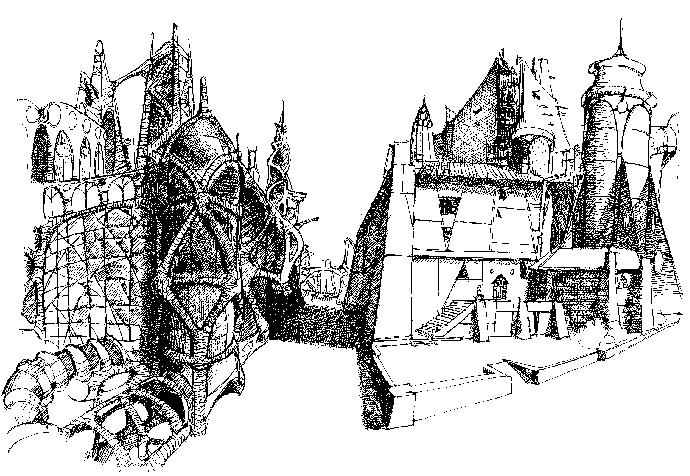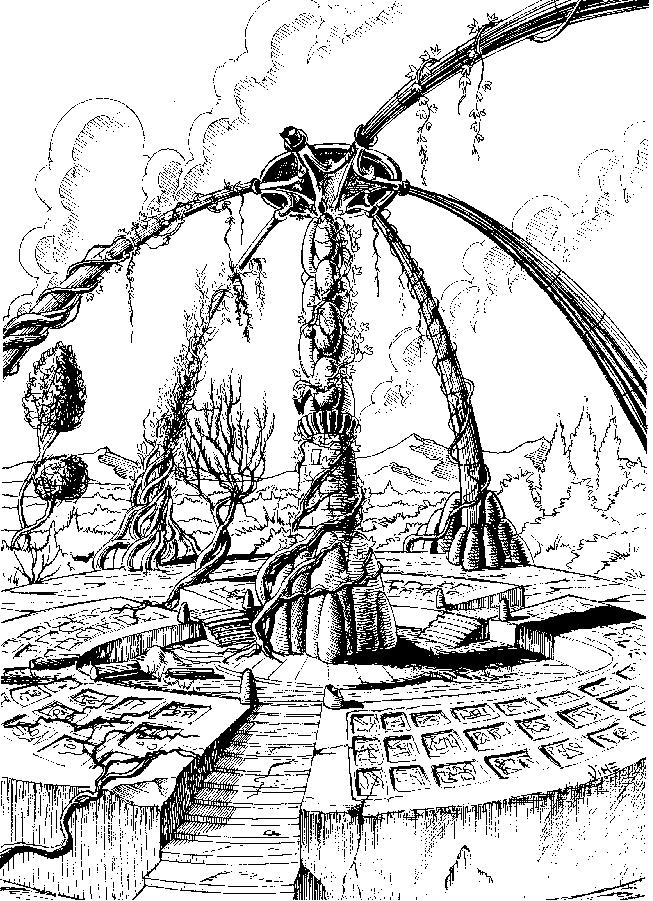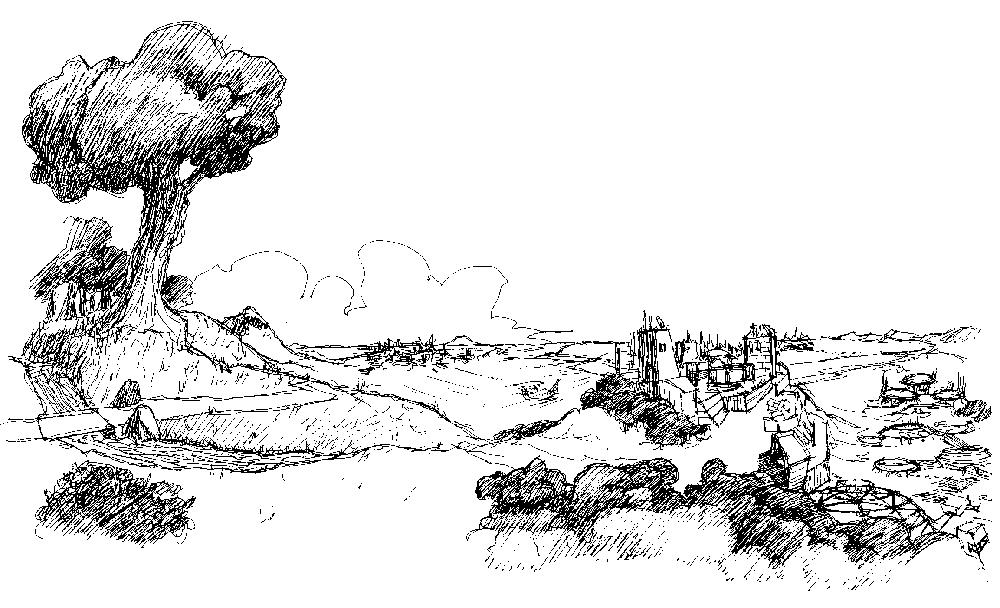CHAPTER 1:
HISTORY
OF
KALANDAR
***
The Old Times
The origins of Kalandar go back a long time,
back to the past centuries of Coruscant's long and complex
history: the still existing ruins date approximately from 10,000
years at least, but it is hard to say precisely if underneath
there are even older ruins hidden or if the method of dating is
reliable.
The recent find of a poem in the ancient idiom
of Coruscant, Dha Vherda Wherda, in which the verses seem to be
written in a language quite similar to the one engraved on many
of the ruins, bring to believe that Kalandar even dates back to
Coruscant's prehistory, when it was inhabited by the planet's
natives and had not yet been elected to capital of the Republic,
but the most authoritative scholars are careful in confirming
this assumption.
A more sinister theory says that Kalandar was
instead built by obscure forces of the Sith Empire during Naga
Sadow's attack on Coruscant. (Circa 5,000 years pre-Empire).
After the Sith forces' defeat on Coruscant, a group of Naga
Sadow's army retreated to a distant area of the planet razing to
the ground the existing Republic structures opposing resistance
for many months before the combined forces of the Republic and
the Jedi Knights definitively wiped them out. But this theory too
does not fully convince scholars as they all agree that the ruins
of Kalandar predate Naga Sadow's invasion but this version does
at least partially contribute to explain the presence of certain
alarming findings that are rumored to be found in the area, along
with the sinister reputation that surrounds some corners of the
region.
Whatever the real origin is Kalandar is, one
thing is sure: it is present in the planet's history since the
origin of Coruscant and it is also considered an important and
fascinating area up to the point after the Fall of the Sith
Empire when the Republic decided to choose Kalandar for a very
special project.
The Origin of the
Gardens of Coruscant
Immediately after the fall of the Sith Empire,
the Republic began a period of prosperity and tranquillity: with
the threat of Naga Sadow eliminated the galaxy feels a strong
need to celebrate the victory achieved and to exalt the power of
the Republic and the Jedi Knights.
It's therefore easy to imagine that both the
members of the Republic Senate and the Jedi Knights were
fascinated by the Kalandar region and its stately and majestic
buildings and stone temples, as well as its wild and still
uncontaminated nature when they had to choose where to pose the
foundations of their most magnificent project: the Gardens of
Coruscant.
Immediately after Naga Sadow's fall, Coruscant,
as almost all of the other planets of the Republic, experienced a
period of great prosperity and growth. The planet itself, greatly
covered by hundreds and hundreds of square kilometers of
plastisteel and metal, is protagonist of a indisputable
expansionism boom and thus begins that process that will
transform it in the totally enveloped planet with multilevels of
buildings and continental districts that it is today.
And because of the increasing expansion, the
Republic's Senate began to worry about preserving some regions of
the planet where its people may still find a functioning
ecosystem and natural scenery. One of these projects, and
actually the most opulent and publicized, was the one that saw
the region of Kalandar transformed into the Garden of Coruscant.
At the time of the first Republican government
intervention, Kalandar was still almost unchanged in respect to
its condition in the old days. A region comprised of approx. 300
km square wide is an expanse of undulating hills and forests
amongst which rise abandoned old cities and austere temples and
buildings in stern gray stone. Already protected and preserved by
numerous decrees that raise it's importance as an archeological
site and that preserved it intact during the past centuries,
Kalandar goes from digging and study site to Republican galactic
monument.
Under careful eye of a select group of Jedi
Knights who permanently settled themselves in Kalandar, begins an
operation that will transform it into one of the wonders of the
Galaxy. Buildings and temples partially buried or crumbling down
are meticulously restored. New trees and new forest areas are
sowed, the most intricate woodlands are tamed and the region is
even repopulated with wildlife.
Soon the region rises to such levels of
splendor that it had not seen probably even during the old days
of its original foundation. The extinct water-courses are
reconveyed and reactivated. And the gardens - a perfect harmony
of nature and monuments - open their doors to visitors from
Coruscant, amazed to find themselves amongst forests, hills and
temples just a few hours after leaving behind them the splendor
of the Republican Capital.
While the rest of the planet continues it's
hectic expansion, Kalandar's fame grows: tourist ships in the
atmosphere point to the small green patch that stands out in the
bright and aseptic surface of the northern hemisphere of the
planet. The Gardens of Coruscant become one of the wonders of the
Galaxy and the Republican Senate's pride.

The Golden Age of
Kalandar
In the following centuries, Kalandar is exactly
what its creators hoped it would be: the capital's garden. A
quiet and solemn region where the planet's inhabitants could find
an environment that elsewhere was growing meager and immerse
themselves in hills and woodlands or gaze upon the ancient
villages and forget the frantic and excitable city lifestyle in
which the rest of the planet was. For those walking amid the
hills of Kalandar, it was quite common to see Jedi Masters,
senators and noblemen walking among statues and columns or on top
of one of the highest mountains in contemplation of the landscape
below. To the Republic's honor it must be said that the
modification of the area into the planet's gardens was done in
total respect of the land's archeology integrity: no new building
was constructed and the ancient ones were restored and made safe
according to the exact instructions of the scholars and experts
of the region. Even the natural interventions were done with
care, aimed exclusively to rebuild the region's natural habitat
as accurately as possible and prohibiting changes or additions of
any type. One of the few real additions done during the
Republic's era was the placing of the Statue of the Force, a
monument that the Republic wanted to erect in honor to the Jedi
Knights on one of the eastern hills of the region.

The Arrival of the
Empire
When the Old Republic collapsed, worn out by
bureaucracy and corruption, in its place arose the New Order:
Senator Palpatine came to power and proclaimed himself Emperor.
It was the Empire's politics to leave a sign as
tangible as possible wherever it's hand could touch especially
where there were still signs of past Republican remains.
Coruscant itself went through swift sudden and extreme changes:
buildings, monuments, historic and cultural sites were absorbed
in the New Order's mechanism: they emerged transformed and
claimed for the Emperor's glory or more simply, destroyed. The
history of the architectural and urban crimes operated in
Coruscant by the Imperial propaganda machine is long and complex
so such disquisition is deferred to later. Suffice it to say that
no place whatever on the planet was saved by the renovation
frantic. Not even Kalandar.
But with Kalandar Imperial bureaucrats found
themselves puzzled. The gardens of Coruscant were one of the
wonders of the Galaxy, and the inhabitants hardly would have
tolerated their destruction. But neither would the Emperor have
tolerated their existence undisturbed, a symbol and a glowing
example of the Republic's and the Jedi knighthood's glory.
The Emperor, as in many other occasions, moved
swiftly and cleverly. After having reassured both the few
inhabitants of the zone and those of the planet that the gardens
would not be touched, he started secretly redirecting the funds
set up for the maintenance and sustenance of the region.
Bureaucratic hindrances and legal obstacles did the rest and soon
Kalandar started to suffer because of bad management and
shortages: without maintenance and adequate supportive structures
the temples and the ancient ruins began to be unsafe. The hills
and forests were growing in an unkempt and intricate way without
personnel to look after it. Delays and breakdowns in the water
drainage, waste- and energy-system plants did the rest. And the
people would protest because of Kalandar's sudden illness.
"Delays accumulated by the Republic's bad
administration" was the official reply of the Imperial
Court. "We are working to repair the damages inflicted"
the court dignitaries would declare... immediately before going
to check that Kalandar's agony would continue.
Once that the situation was sufficiently
serious the Emperor offered the perfect solution for those who
wanted the region restored to its original splendor: Kalandar was
to be sold off. Private citizens who would supply funds and
prompt intervention that the Senate could not guarantee anymore
would take the supervision.
In writing, precise guarantee was given on the
fact that such private citizens would have to follow the same
rules in force during Republic times: the obligation on the
maintenance of the existing structures, of the area's original
habitat, etc.; but in reality Palpatine was working on the exact
contrary.
Playing on many ambitious representatives of
the newly born New Order, Kalandar was presented as a glamorous
area where to live: where would be the best base for those of the
Imperial ?lite if not in the area that was once the famous
Republican gardens? The fever carefully orchestrated at court and
at the business circles, rapidly spread. Soon all those
representatives wanted a piece of Kalandar. And the Imperial
court was more than happy to close an eye, and perhaps both, on
the many and repeated infractions that were being effected
against the region's protection decrees. The temples were
transformed in luxury residences for the powerful. The old
villages in meeting and relaxation centers for the aristocracy
and the young. Acres of woodland were cut down "to clean out
the land of those trees growing out of control". Metal was
inserted on the stone and so the slow and fatal erosion of
Kalandar had begun.
When Kalandar was sufficiently devastated that
it was but a feeble memory of what it once was, the Emperor
considered himself satisfied. Woodlands, hills and stone
buildings were still there but they were a sad version of the
gardens they used to be. Metal and plastisteel tubes were tearing
into the sides of castles and palaces. Antennas and transmitters
were placed on top of towers and walls. Landing platforms and
maintenance tanks were ripping out the woodland and the
hillsides.
Manipulated once again by a court fashion, the
rich and powerful soon got tired of Kalandar. Some remained but
many left for new destinations leaving behind them a ruined and
tortured land. The strange tangle of greenery, stone and
technology had nothing whatsoever to do with the magnificent
republican planetary gardens. Satisfied with having corrupted
from the inside one of the last Republican symbols, Palpatine
turned his attention to another of his never-ending projects and
paid the region no more attention.
Kalandar Today
Little or nothing has changed for Kalandar
during the last years. The few visitors that go there today,
together by being amazed at finding themselves in the open air at
just a short distance from the Imperial Center, only feel a sense
of annoyance and discomfort. Nobody looks after the region
anymore or worries about what happens to it, and just the sight
of the carbon freezing ducts that cover the villages' old access
pillars are more than enough to dissuade them from moving on. The
air, though relatively clean, is becoming ruined by the pollution
that afflicts the rest of the planet, since many of the purifiers
that would have kept it crystal clean are broken or have been
dismantled by looters.
Kalandar today is still green, with its hills
and forests but they are zones where the plant life has grown
wild and harsh, or else weary and feeble. Furthermore the areas
where the countryside was not corrupted by the many settlements
that the Imperial fever had caused are rare.
Villages and buildings abandoned by the
Imperial ?lite now belong to small business-men or investors who
thought they were getting a real bargain without knowing that the
Empire had already decreed the region's death, or to the
underprivileged and outcasts that now can buy land and buildings
for a handful of credits. Then there are the refugees, bandits,
or unpleasant beings that have found shelter among the ruins:
many buildings were abandoned and are unused and nobody claims
them.
The Spirit of Kalandar

In any case, even if a Republican of the old
days would feel broken-hearted at the sight of Kalandar today,
the region is not totally destroyed and annihilated. Sick and
suffering it is, even wounded and corrupted, but not yet dead.
Even if electric and network plants bore into the stones of
buildings, low quality holographic signs light up streets paved
in stone and cooling liquids are released into the lakes between
the hills, the region still retains a glimpse of it's past glory.
The castles, temples and houses seem sad sleeping giants, but
from their chiseled walls and stone arches still transpires a
faint glow of it's past magnificence. Stubbornly grass and
vegetation still manage to grow between the metal plates of the
landing strips and an odd climate with many storms and sudden
changes of temperatures and pressure seems to make fun of the
surrounding artificial climate devices.
Even among the social outcasts of Kalandar
there are still those who care for the area's future. Some are
nostalgic Republicans who perceived Palpatine's maneuvers and so
quickly bought land when it went to sale. Even if it is too late
to save the region they do their best possible to cure and
preserve their properties as it used to be done. Even some
Imperial aristocrats, once they bought the land, ended up falling
in love with the region and did not follow the majority of the
court that followed the fashions maneuvered from above. Though
still remaining loyal supporters of the Empire, they are careful
that their property remains clean and untouched.
But these are happy islands in a sea that
continues slowly and unrelentingly to be polluted and corrupted.
Moral and environmental corruption goes hand in hand. The more
the surroundings of Kalandar become unpleasant, the more the area
attracts unwelcome beings. Because for outlaws, bandits and
subversives, Kalandar is a good place where to lose their tracks.
There is a small detachment of local Imperial troops, but it is
more of a punishment for the trooper that is sent there than an
actual control on the zone.
Paradoxically the unwanted elements of the
Empire and those searched by them are usually people with a
strong will and honest moral: Rebels, political persecutes,
deserters and non-violent protesters. If you scratch off
Kalandar's harsh surface, and avoid the real criminals
nevertheless present, it is easier than what is thought to find
persons that are better than what appearances show.
Back to Kalandar Main

